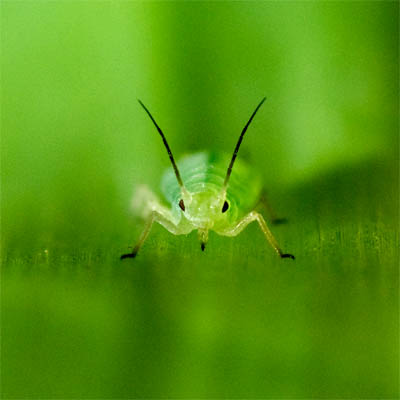|
|
USDA scientists have found a way to distinguish aphids that spread plant viruses from those that do not. That discovery might ultimately mean growers battling the insect could cut back on the expense and time necessary to apply insecticides.
The findings mark the first time that protein biomarkers have been linked to an insect’s ability to transmit viruses.
Aphids can transmit viruses that cause crop diseases. But, not all aphids transmit viruses. So a key question for growers is knowing when and what to spray to control viral diseases.
Agricultural Research Service scientists Michelle Cilia and Stewart Gray, in the Biological Integrated Pest Management Unit at the Robert W. Holley Center for Agriculture and Health in Ithaca, New York, have found a way to distinguish aphids that spread viruses from those that don’t—by studying the aphid’s proteins.
They knew from previous work that for aphids to pick up and transmit viruses, the virus must be able to interact with specific aphid proteins that direct movement of the virus through the insect and back into a plant during feeding.
In laboratory studies of greenbug aphids, they discovered that the laboratory-raised insects’ ability to transmit yellow dwarf viruses could be predicted by the presence or absence of nine different biomarker proteins in the insect cells.
To see if their lab findings would prove true in the field, they analyzed greenbug aphids collected from cereal crops and noncultivated grasses around the United States by ARS colleagues John Burd and Melissa Burrows, of the Wheat, Peanut, and Other Field Crops Research Unit in Stillwater, Oklahoma.
The researchers found the field-collected aphids consistently transmitted yellow dwarf virus only when they carried most, if not all, of the nine key biomarker proteins. “The aphid does not need all nine to spread the yellow dwarf virus, but some are essential,” Cilia says. The discovery in the lab was published in the March 2011 issue of the Journal of Virology, and the study confirming the biomarkers in the field was reported in Proteomics in June 2011.
The findings mark the first time that protein biomarkers have been linked to an insect’s ability to transmit viruses, and the discovery is expected to lead to development of a test to identify potential disease vectors.
Cilia and Gray are also collaborating on an effort to test whether the biomarker proteins can predict disease-vectoring ability in other insects. Collaborators include Michael MacCoss and Michael Bereman at the University of Washington; Alvin Simmons at ARS’s U.S. Vegetable Laboratory in Charleston, South Carolina; and Lava Kumar and Rachid Hanna at the International Institute of Tropical Agriculture in Africa.
The project is being funded by the National Science Foundation Basic Research to Enable Agricultural Development program through Cornell University, with support from the Bill & Melinda Gates Foundation.

 Close-up of greenbug aphid, Schizaphis graminum, showing the piercing-sucking mouthparts it uses to feed and inject virus into plants. (USDA photo)
Close-up of greenbug aphid, Schizaphis graminum, showing the piercing-sucking mouthparts it uses to feed and inject virus into plants. (USDA photo)




Post a comment
Report Abusive Comment